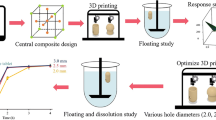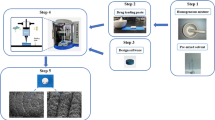Abstract
Following recent advances in nutrigenomics and nutrigenetics, as well as in view of the increasing use of nutraceuticals in combination with drug treatments, considerable attention is being directed to the composition, bioefficacy, and release performance of dietary supplements. Moreover, the interest in the possibility of having such products tailored to meet specific needs is fast growing among costumers. To fulfill these emerging market trends, 3D-printed capsular devices originally intended for conveyance and administration of drugs were proposed for delivery of dietary supplements. Being composed of separate inner compartments, such a device could yield customized combinations of substances, relevant doses, and release kinetics. In particular, the aim of this work was to face early-stage industrial development of the processes involved in fabrication of nutraceutical capsules for oral pulsatile delivery. A pilot plant for extrusion of filaments based on pharmaceutical-grade polymers and intended for 3D printing was set up, and studies aimed at demonstrating feasibility of fused deposition modeling in 3D printing of capsule shells according to Current Good Manufacturing Practices for dietary supplements were undertaken. In this respect, the stability of the starting material after hot processing and of the resulting items was investigated, and compliance of elemental and microbiological contaminants, as well as of by-products, with internal specifications was assessed. Finally, operating charts highlighting critical process variables and parameters that would serve as indices of both intermediate and final product quality were developed.










Similar content being viewed by others
References
Gazzaniga A, Cerea M, Cozzi A, Foppoli A, Maroni A, Zema L. A novel injection-molded capsular device for oral pulsatile delivery based on swellable/erodible polymers. AAPS PharmSciTech. 2011;12:295–303.
Zema L, Loreti G, Macchi E, Foppoli A, Maroni A, Gazzaniga A. Injection-molded capsular device for oral pulsatile release: development of a novel mold. J Pharm Sci. 2013;102:489–99.
Zema L, Loreti G, Melocchi A, Maroni A, Palugan L, Gazzaniga A. Gastroresistant capsular device prepared by injection molding. Int J Pharm. 2013;440:264–72.
Melocchi A, Parietti F, Loreti G, Maroni A, Gazzaniga A, Zema L. 3D printing by fused deposition modeling (FDM) of a swellable/erodible capsular device for oral pulsatile release of drugs. J Drug Deliv Sci Technol. 2015;30 Part B:360–7.
Maroni A, Melocchi A, Parietti F, Foppoli A, Zema L, Gazzaniga A. 3D printed multi-compartment capsular devices for two-pulse oral drug delivery. J Control Release. 2017;268:10–8.
Melocchi A, Parietti F, Maroni A, Foppoli A, Gazzaniga A, Zema L. Hot-melt extruded filaments based on pharma-grade polymers for 3D printing by fused deposition modeling. Int J Pharm. 2016;509:255–63.
Zema L, Loreti G, Melocchi A, Maroni A, Gazzaniga A. Injection molding and its application to drug delivery. J Control Release. 2012;159:324–31.
Zema L, Melocchi A, Maroni A, Gazzaniga A. 3D printing of medicinal products and the challenge of personalized medicine. J Pharm Sci. 2017;106:1697–705.
Sun Y, Soh S. Printing tablets with fully customizable release profiles for personalized medicine. Adv Mater. 2015;27:7847–53.
Kussmann M, Fay LB. Nutrigenomics and personalized nutrition: science and concept. Pers Med. 2008;5:447–55.
Eussen SRBM, Verhagen H, Klungel OH, Garssen J, van Loveren H, van Kranen HJ, et al. Functional foods and dietary supplements: products at the interface between pharma and nutrition. Eur J Pharmacology. 2011;668:S2–9.
Ostan R, Béné MC, Spazzafumo L, Pinto A, Donini LM, Pryen F, et al. Impact of diet and nutraceutical supplementation on inflammation in elderly people. Results from the RISTOMED study, an open-label randomized control trial. Clin Nutr. 2016;35:812–8.
Braithwaite MC, Tyagi C, Tomar LK, Kumar P, Choonara YE, Pillay V. Nutraceutical-based therapeutics and formulation strategies augmenting their efficiency to complement modern medicine: an overview. J Funct Foods. 2014;6:82–9.
Ting Y, Jiang Y, Ho C-T, Huang Q. Common delivery systems for enhancing in vivo bioavailability and biological efficacy of nutraceuticals. J Funt Foods. 2014;7:112–28.
Gazzaniga A, Busetti C, Moro L, Sangalli ME, Giordano F. Time-dependent oral delivery systems for colon-targeting. STP Pharma. 1995;5:83–8.
http://www.ashland.com/file_source/Ashland/Product/Documents/Pharmaceutical/PC_11229_Klucel_HPC.pdf, Accessed 15 Dec 2017.
Prodduturi S, Manek RV, Kolling WM, Stodghill SP, Repka MA. Water vapor sorption of hot-melt extruded hydroxypropyl cellulose films: effect on physico-mechanical properties, release characteristics, and stability. J Pharm Sci. 2004;93:3047–56.
Sarode AL, Malekar SA, Cote C, Worthen DR. Hydroxypropyl cellulose stabilizes amorphous solid dispersions of the poorly water soluble drug felodipine. Carbohydr Polym. 2014;112:512–9.
Loreti G, Maroni A, Del Curto MD, Melocchi A, Gazzaniga A, Zema L. Evaluation of hot-melt extrusion technique in the preparation of HPC matrices for prolonged release. Eur J Pharm Sci. 2014;52:77–85.
https://www.fda.gov/food/guidanceregulation/guidancedocumentsregulatoryinformation/dietarysupplements/ucm238182.htm, Accessed 15 Dec 2017.
Wittgren B, Porsch P. Molar mass distribution of hydroxypropyl cellulose by size exclusion chromatography with dual light scattering and refractometric detection. Carbohydr Polym. 2002;49:457–69.
Perale G, Giordano C, Daniele F, Tunesi M, Colombo P, Gottardo L, et al. Extruded ceramic microelectrodes for biomedical applications. Int J Artif Organs. 2008;31:272–8.
Perale G, Pertici G, Giordano C, Daniele F, Masi M, Maccagnan S. Nondegradative microextrusion of resorbable polyesters for pharmaceutical and biomedical applications: the cases of poly-lactic-acid and poly-caprolactone. J Appl Polym Sci. 2008;108:1591–5.
Perale G, Arosio P, Moscatelli D, Barri V, Müller M, Maccagnan S, et al. A new model of resorbable device degradation and drug release: transient 1-dimension diffusional model. J Control Release. 2009;136:196–205.
Perale G, Casalini T, Barri V, Mueller M, Maccagnan S, Masi M. Lidocaine release from polycaprolactone threads. J Appl Polym Sci. 2010;117:3610–4.
Pertici G, Maccagnan S, Müller M, Rossi F, Daniele F, Tunesi M, et al. Porous biodegradable microtubes-based scaffolds for tissue engineering, part I: production and preliminary in vitro evaluation. J Appl Biomater Biomech. 2008;6:186–92.
Author information
Authors and Affiliations
Corresponding author
Additional information
Guest Editors: Niklas Sandler and Jukka Rantanen
Rights and permissions
About this article
Cite this article
Melocchi, A., Parietti, F., Maccagnan, S. et al. Industrial Development of a 3D-Printed Nutraceutical Delivery Platform in the Form of a Multicompartment HPC Capsule. AAPS PharmSciTech 19, 3343–3354 (2018). https://doi.org/10.1208/s12249-018-1029-9
Received:
Accepted:
Published:
Issue Date:
DOI: https://doi.org/10.1208/s12249-018-1029-9




